ACC 200 Report: Cost Allocation Methods Analysis at Beztec Limited
VerifiedAdded on 2023/06/05
|15
|2829
|76
Report
AI Summary
This report provides a detailed analysis of cost allocation methods, specifically focusing on traditional costing and activity-based costing (ABC), and their impact on decision-making within an organization, using Beztec Limited as a case study. The report evaluates the importance of selecting the correct costing method, analyzes Beztec Limited's cost data, and offers recommendations to the accountant, Sue Smith, regarding the implementation of ABC. It also includes an analysis of the company's gross profit margin under both costing methods and discusses the treatment of under- or over-recovery of overhead costs. The findings reveal that the initial decision to phase out a product (Lexon) based on traditional costing was flawed and that ABC provides a more accurate representation of product profitability, highlighting the ethical responsibilities of accountants in providing unbiased financial information.

ACC 200
Paraphrase This Document
Need a fresh take? Get an instant paraphrase of this document with our AI Paraphraser
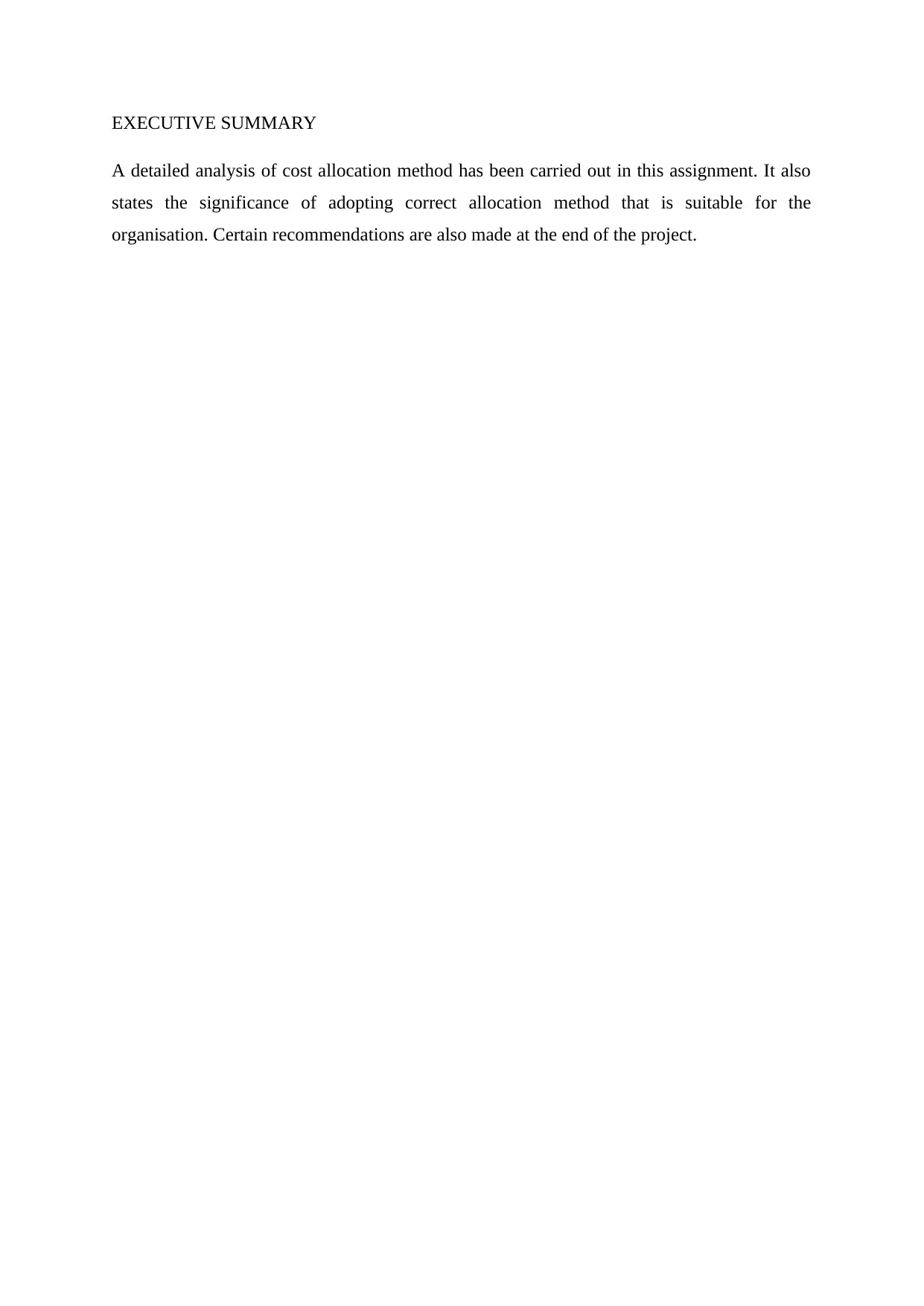
EXECUTIVE SUMMARY
A detailed analysis of cost allocation method has been carried out in this assignment. It also
states the significance of adopting correct allocation method that is suitable for the
organisation. Certain recommendations are also made at the end of the project.
A detailed analysis of cost allocation method has been carried out in this assignment. It also
states the significance of adopting correct allocation method that is suitable for the
organisation. Certain recommendations are also made at the end of the project.
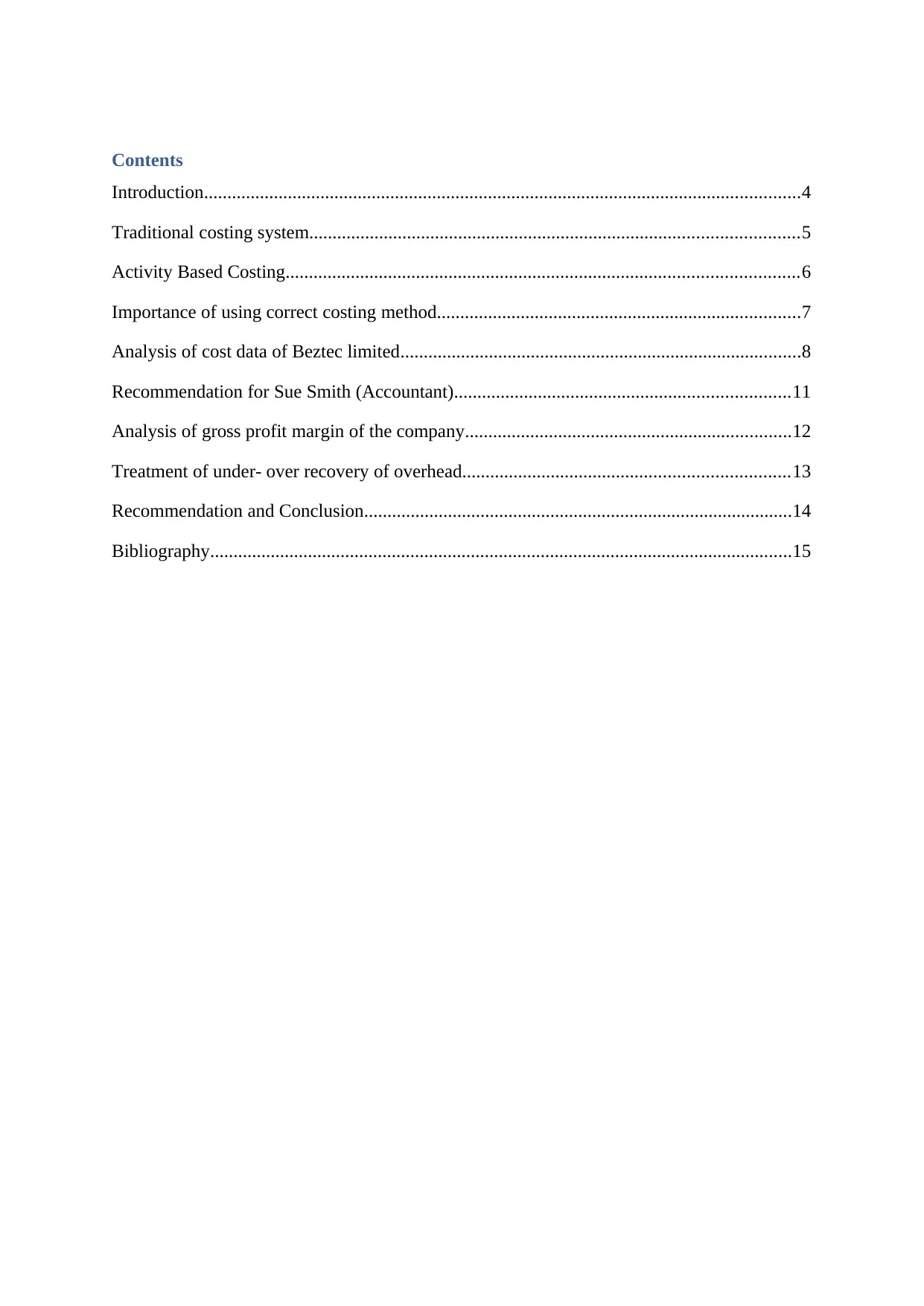
Contents
Introduction................................................................................................................................4
Traditional costing system.........................................................................................................5
Activity Based Costing..............................................................................................................6
Importance of using correct costing method..............................................................................7
Analysis of cost data of Beztec limited......................................................................................8
Recommendation for Sue Smith (Accountant)........................................................................11
Analysis of gross profit margin of the company......................................................................12
Treatment of under- over recovery of overhead......................................................................13
Recommendation and Conclusion............................................................................................14
Bibliography.............................................................................................................................15
Introduction................................................................................................................................4
Traditional costing system.........................................................................................................5
Activity Based Costing..............................................................................................................6
Importance of using correct costing method..............................................................................7
Analysis of cost data of Beztec limited......................................................................................8
Recommendation for Sue Smith (Accountant)........................................................................11
Analysis of gross profit margin of the company......................................................................12
Treatment of under- over recovery of overhead......................................................................13
Recommendation and Conclusion............................................................................................14
Bibliography.............................................................................................................................15
⊘ This is a preview!⊘
Do you want full access?
Subscribe today to unlock all pages.

Trusted by 1+ million students worldwide
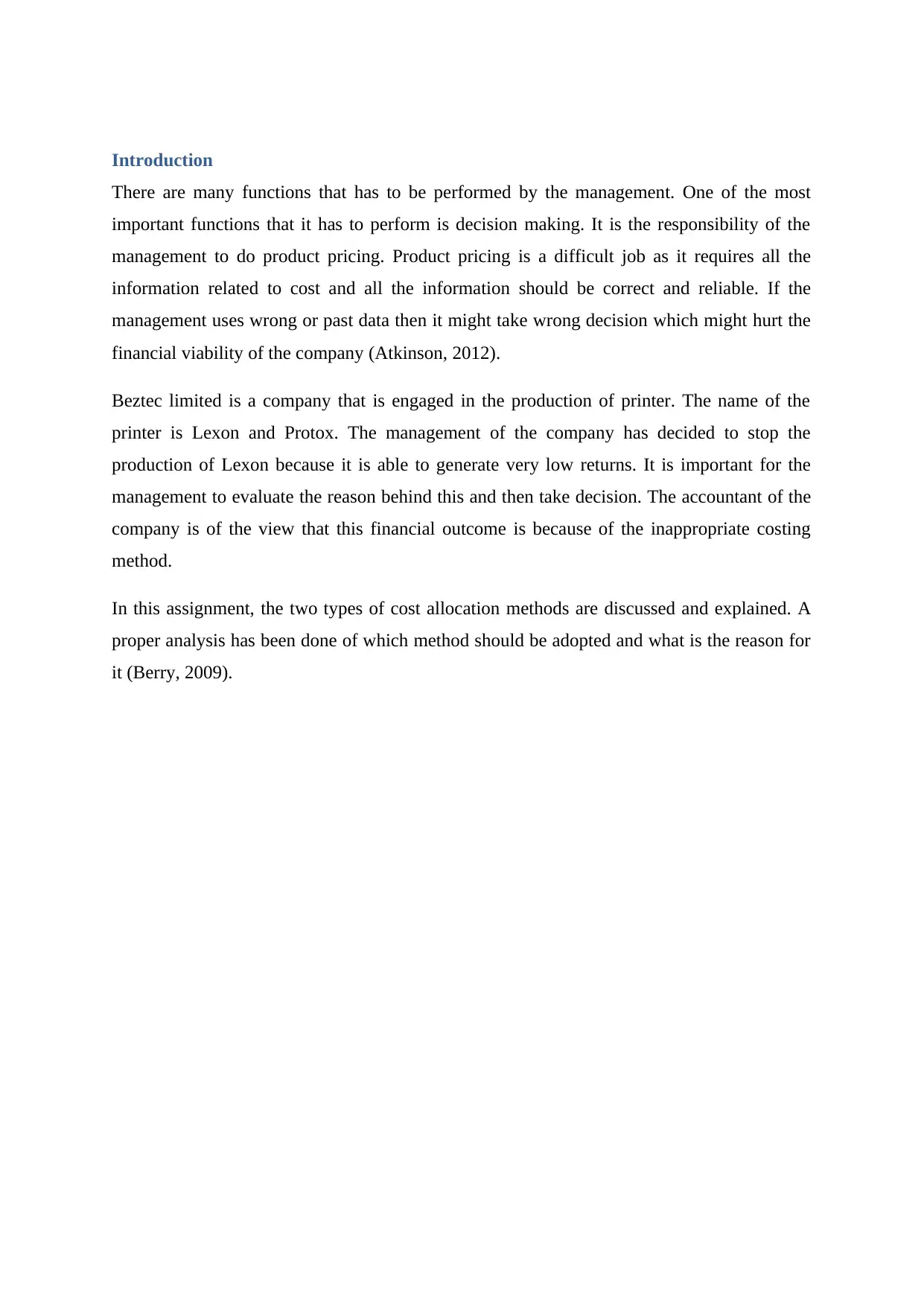
Introduction
There are many functions that has to be performed by the management. One of the most
important functions that it has to perform is decision making. It is the responsibility of the
management to do product pricing. Product pricing is a difficult job as it requires all the
information related to cost and all the information should be correct and reliable. If the
management uses wrong or past data then it might take wrong decision which might hurt the
financial viability of the company (Atkinson, 2012).
Beztec limited is a company that is engaged in the production of printer. The name of the
printer is Lexon and Protox. The management of the company has decided to stop the
production of Lexon because it is able to generate very low returns. It is important for the
management to evaluate the reason behind this and then take decision. The accountant of the
company is of the view that this financial outcome is because of the inappropriate costing
method.
In this assignment, the two types of cost allocation methods are discussed and explained. A
proper analysis has been done of which method should be adopted and what is the reason for
it (Berry, 2009).
There are many functions that has to be performed by the management. One of the most
important functions that it has to perform is decision making. It is the responsibility of the
management to do product pricing. Product pricing is a difficult job as it requires all the
information related to cost and all the information should be correct and reliable. If the
management uses wrong or past data then it might take wrong decision which might hurt the
financial viability of the company (Atkinson, 2012).
Beztec limited is a company that is engaged in the production of printer. The name of the
printer is Lexon and Protox. The management of the company has decided to stop the
production of Lexon because it is able to generate very low returns. It is important for the
management to evaluate the reason behind this and then take decision. The accountant of the
company is of the view that this financial outcome is because of the inappropriate costing
method.
In this assignment, the two types of cost allocation methods are discussed and explained. A
proper analysis has been done of which method should be adopted and what is the reason for
it (Berry, 2009).
Paraphrase This Document
Need a fresh take? Get an instant paraphrase of this document with our AI Paraphraser
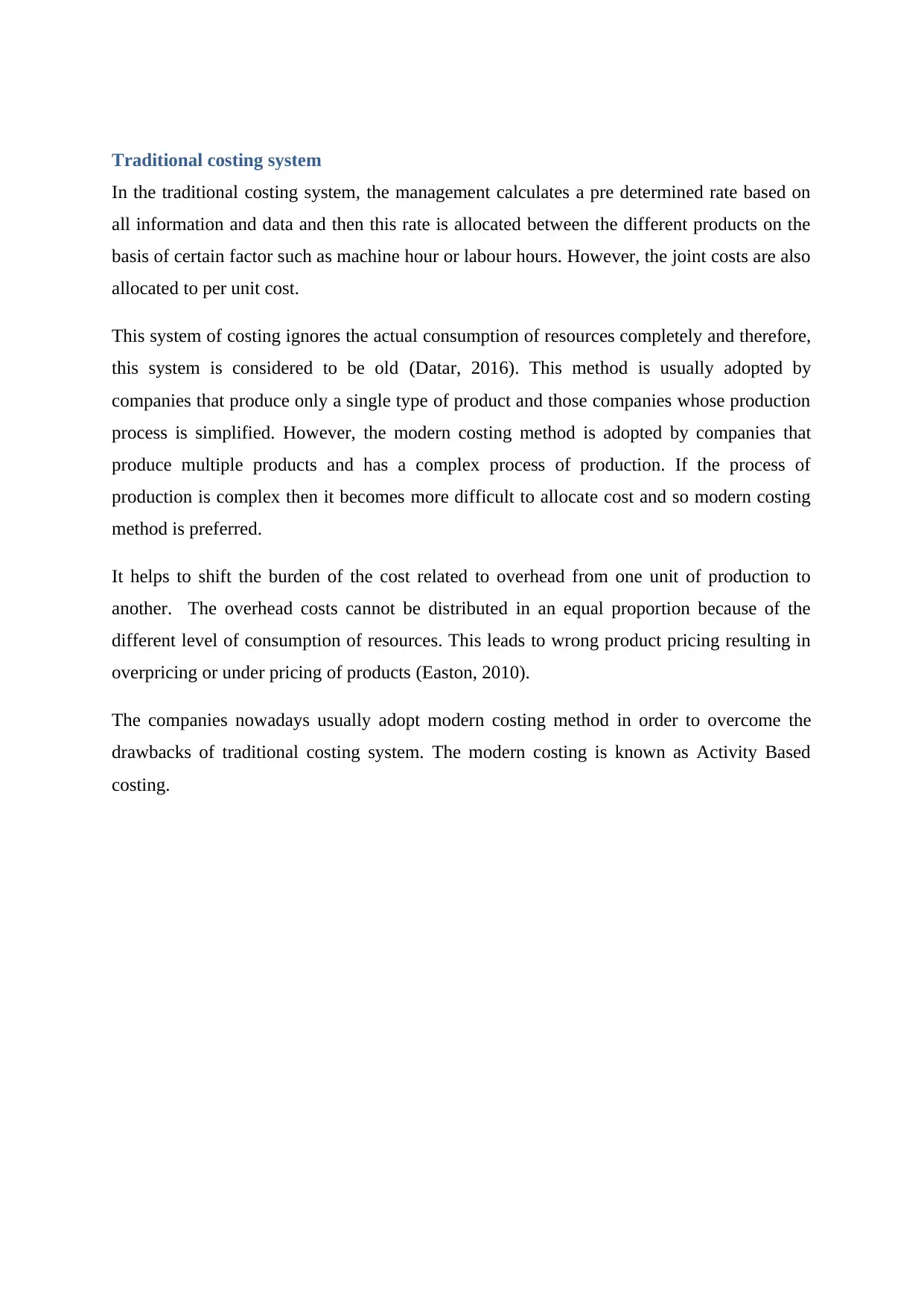
Traditional costing system
In the traditional costing system, the management calculates a pre determined rate based on
all information and data and then this rate is allocated between the different products on the
basis of certain factor such as machine hour or labour hours. However, the joint costs are also
allocated to per unit cost.
This system of costing ignores the actual consumption of resources completely and therefore,
this system is considered to be old (Datar, 2016). This method is usually adopted by
companies that produce only a single type of product and those companies whose production
process is simplified. However, the modern costing method is adopted by companies that
produce multiple products and has a complex process of production. If the process of
production is complex then it becomes more difficult to allocate cost and so modern costing
method is preferred.
It helps to shift the burden of the cost related to overhead from one unit of production to
another. The overhead costs cannot be distributed in an equal proportion because of the
different level of consumption of resources. This leads to wrong product pricing resulting in
overpricing or under pricing of products (Easton, 2010).
The companies nowadays usually adopt modern costing method in order to overcome the
drawbacks of traditional costing system. The modern costing is known as Activity Based
costing.
In the traditional costing system, the management calculates a pre determined rate based on
all information and data and then this rate is allocated between the different products on the
basis of certain factor such as machine hour or labour hours. However, the joint costs are also
allocated to per unit cost.
This system of costing ignores the actual consumption of resources completely and therefore,
this system is considered to be old (Datar, 2016). This method is usually adopted by
companies that produce only a single type of product and those companies whose production
process is simplified. However, the modern costing method is adopted by companies that
produce multiple products and has a complex process of production. If the process of
production is complex then it becomes more difficult to allocate cost and so modern costing
method is preferred.
It helps to shift the burden of the cost related to overhead from one unit of production to
another. The overhead costs cannot be distributed in an equal proportion because of the
different level of consumption of resources. This leads to wrong product pricing resulting in
overpricing or under pricing of products (Easton, 2010).
The companies nowadays usually adopt modern costing method in order to overcome the
drawbacks of traditional costing system. The modern costing is known as Activity Based
costing.
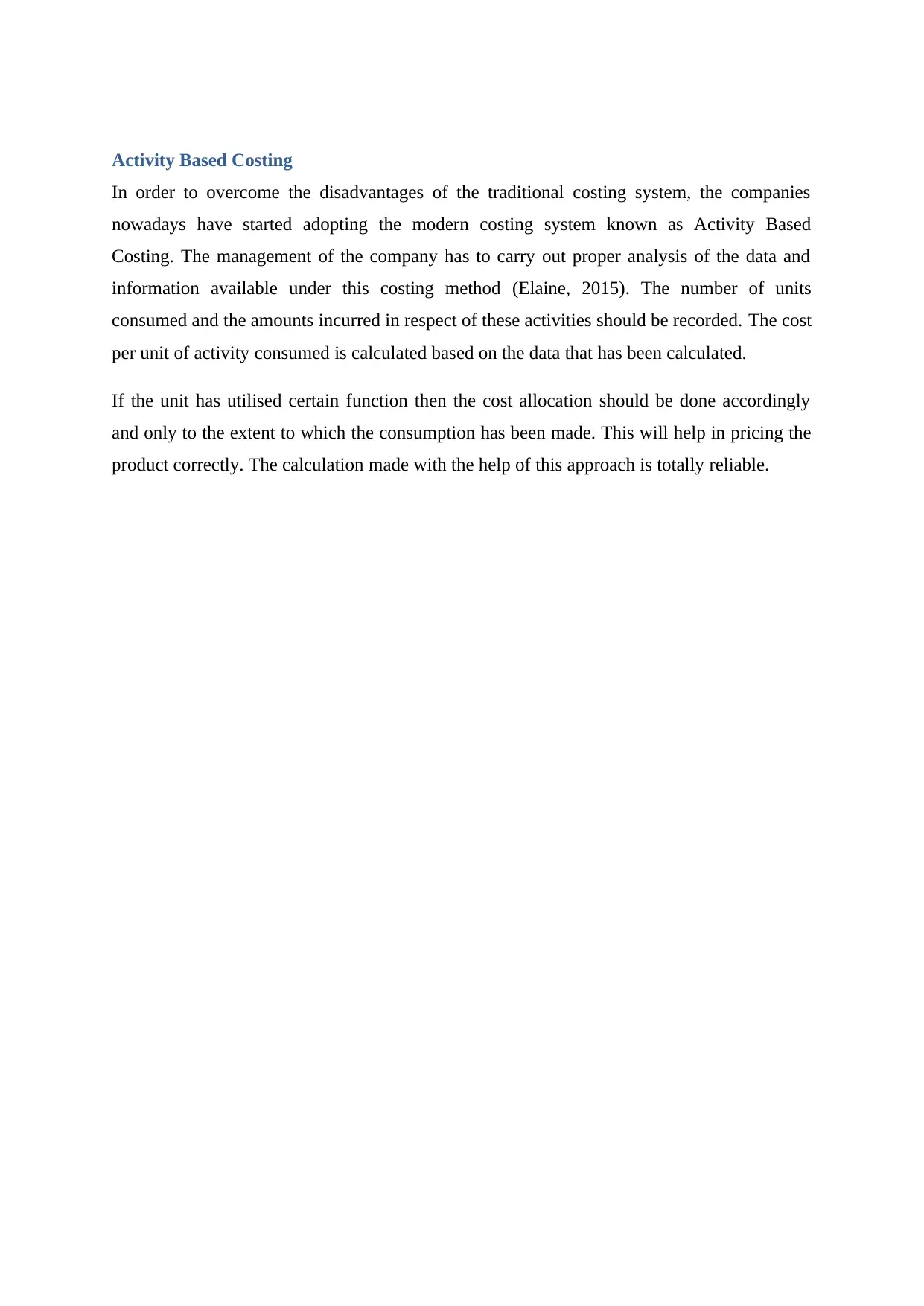
Activity Based Costing
In order to overcome the disadvantages of the traditional costing system, the companies
nowadays have started adopting the modern costing system known as Activity Based
Costing. The management of the company has to carry out proper analysis of the data and
information available under this costing method (Elaine, 2015). The number of units
consumed and the amounts incurred in respect of these activities should be recorded. The cost
per unit of activity consumed is calculated based on the data that has been calculated.
If the unit has utilised certain function then the cost allocation should be done accordingly
and only to the extent to which the consumption has been made. This will help in pricing the
product correctly. The calculation made with the help of this approach is totally reliable.
In order to overcome the disadvantages of the traditional costing system, the companies
nowadays have started adopting the modern costing system known as Activity Based
Costing. The management of the company has to carry out proper analysis of the data and
information available under this costing method (Elaine, 2015). The number of units
consumed and the amounts incurred in respect of these activities should be recorded. The cost
per unit of activity consumed is calculated based on the data that has been calculated.
If the unit has utilised certain function then the cost allocation should be done accordingly
and only to the extent to which the consumption has been made. This will help in pricing the
product correctly. The calculation made with the help of this approach is totally reliable.
⊘ This is a preview!⊘
Do you want full access?
Subscribe today to unlock all pages.

Trusted by 1+ million students worldwide
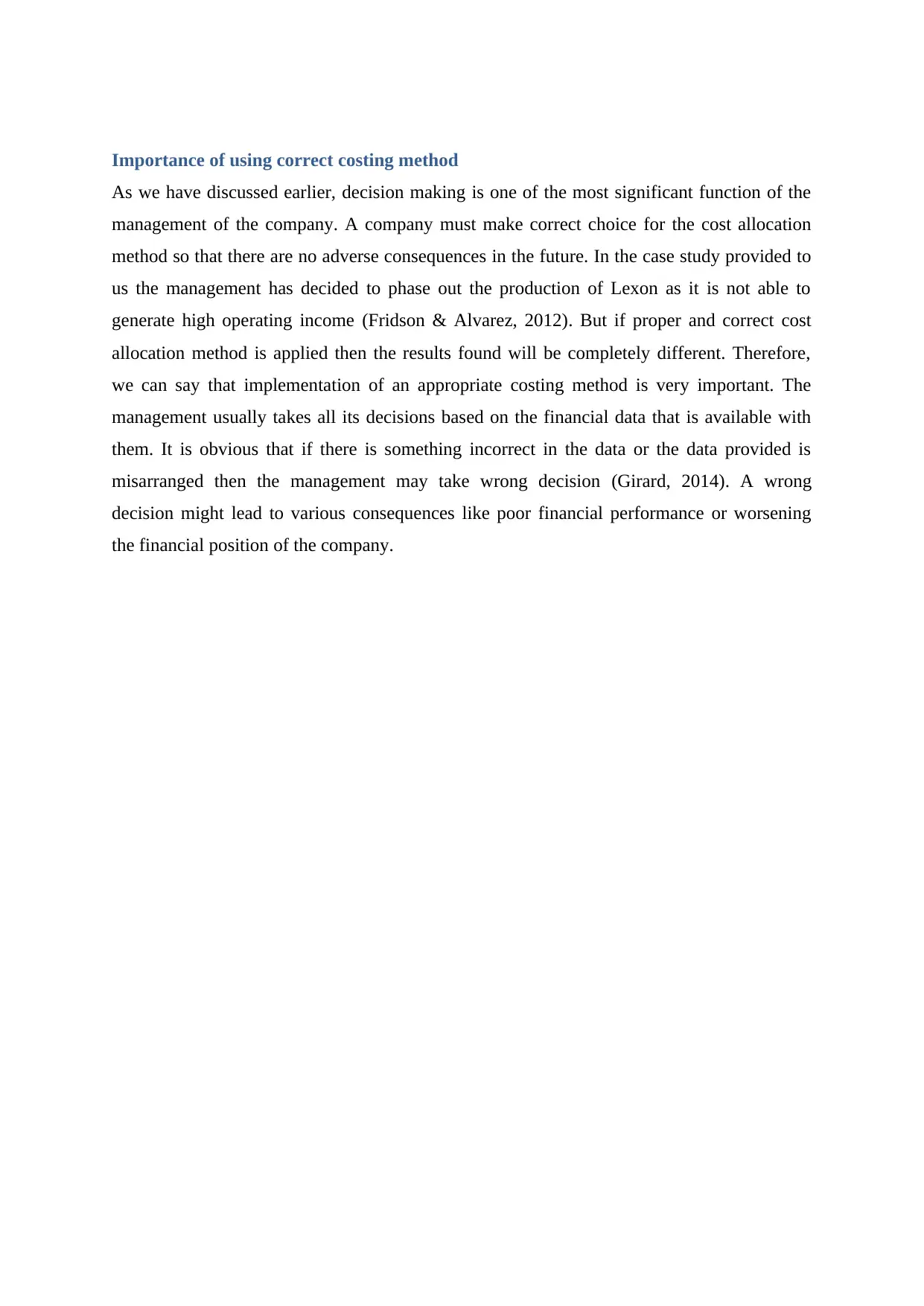
Importance of using correct costing method
As we have discussed earlier, decision making is one of the most significant function of the
management of the company. A company must make correct choice for the cost allocation
method so that there are no adverse consequences in the future. In the case study provided to
us the management has decided to phase out the production of Lexon as it is not able to
generate high operating income (Fridson & Alvarez, 2012). But if proper and correct cost
allocation method is applied then the results found will be completely different. Therefore,
we can say that implementation of an appropriate costing method is very important. The
management usually takes all its decisions based on the financial data that is available with
them. It is obvious that if there is something incorrect in the data or the data provided is
misarranged then the management may take wrong decision (Girard, 2014). A wrong
decision might lead to various consequences like poor financial performance or worsening
the financial position of the company.
As we have discussed earlier, decision making is one of the most significant function of the
management of the company. A company must make correct choice for the cost allocation
method so that there are no adverse consequences in the future. In the case study provided to
us the management has decided to phase out the production of Lexon as it is not able to
generate high operating income (Fridson & Alvarez, 2012). But if proper and correct cost
allocation method is applied then the results found will be completely different. Therefore,
we can say that implementation of an appropriate costing method is very important. The
management usually takes all its decisions based on the financial data that is available with
them. It is obvious that if there is something incorrect in the data or the data provided is
misarranged then the management may take wrong decision (Girard, 2014). A wrong
decision might lead to various consequences like poor financial performance or worsening
the financial position of the company.
Paraphrase This Document
Need a fresh take? Get an instant paraphrase of this document with our AI Paraphraser
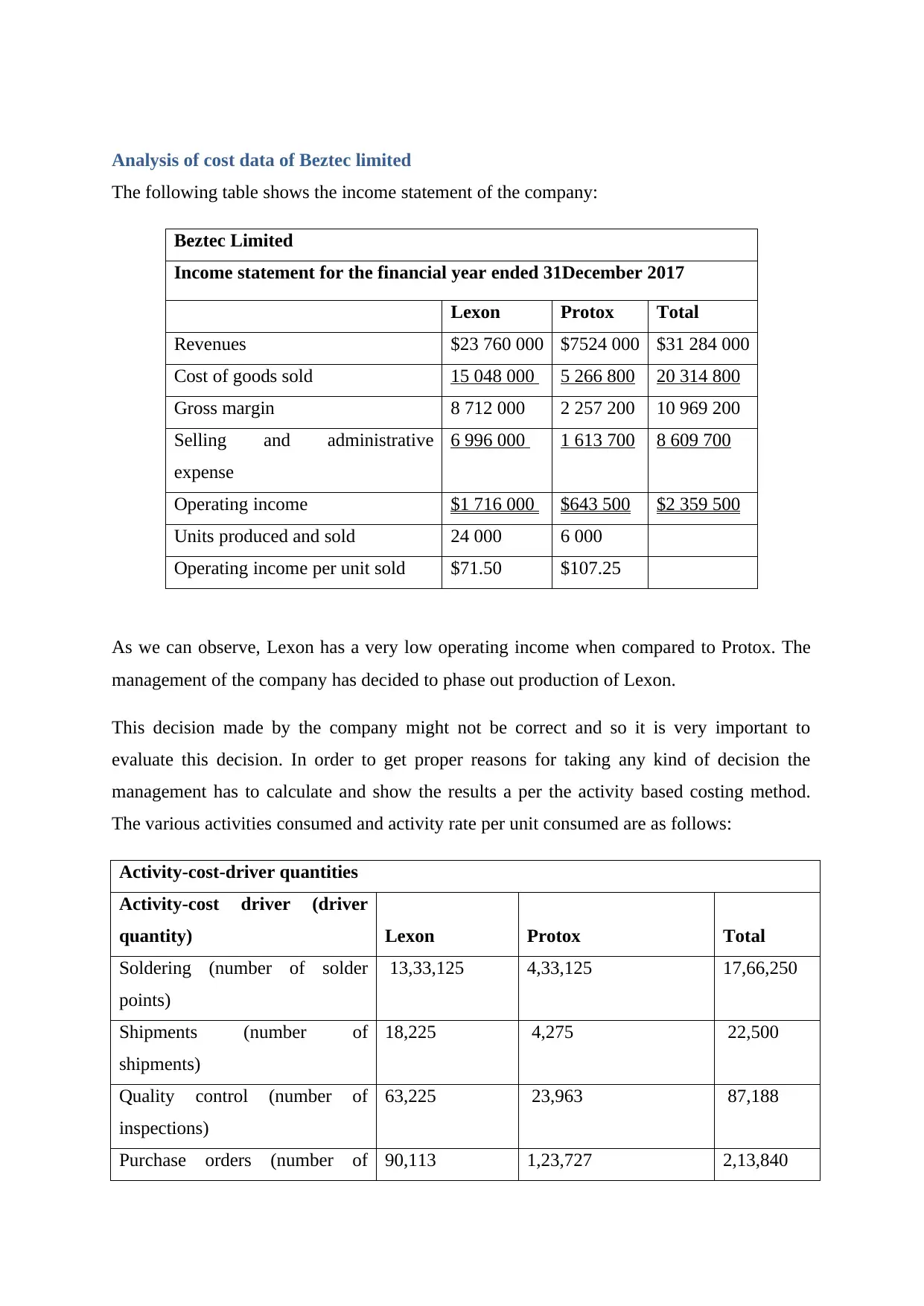
Analysis of cost data of Beztec limited
The following table shows the income statement of the company:
Beztec Limited
Income statement for the financial year ended 31December 2017
Lexon Protox Total
Revenues $23 760 000 $7524 000 $31 284 000
Cost of goods sold 15 048 000 5 266 800 20 314 800
Gross margin 8 712 000 2 257 200 10 969 200
Selling and administrative
expense
6 996 000 1 613 700 8 609 700
Operating income $1 716 000 $643 500 $2 359 500
Units produced and sold 24 000 6 000
Operating income per unit sold $71.50 $107.25
As we can observe, Lexon has a very low operating income when compared to Protox. The
management of the company has decided to phase out production of Lexon.
This decision made by the company might not be correct and so it is very important to
evaluate this decision. In order to get proper reasons for taking any kind of decision the
management has to calculate and show the results a per the activity based costing method.
The various activities consumed and activity rate per unit consumed are as follows:
Activity-cost-driver quantities
Activity-cost driver (driver
quantity) Lexon Protox Total
Soldering (number of solder
points)
13,33,125 4,33,125 17,66,250
Shipments (number of
shipments)
18,225 4,275 22,500
Quality control (number of
inspections)
63,225 23,963 87,188
Purchase orders (number of 90,113 1,23,727 2,13,840
The following table shows the income statement of the company:
Beztec Limited
Income statement for the financial year ended 31December 2017
Lexon Protox Total
Revenues $23 760 000 $7524 000 $31 284 000
Cost of goods sold 15 048 000 5 266 800 20 314 800
Gross margin 8 712 000 2 257 200 10 969 200
Selling and administrative
expense
6 996 000 1 613 700 8 609 700
Operating income $1 716 000 $643 500 $2 359 500
Units produced and sold 24 000 6 000
Operating income per unit sold $71.50 $107.25
As we can observe, Lexon has a very low operating income when compared to Protox. The
management of the company has decided to phase out production of Lexon.
This decision made by the company might not be correct and so it is very important to
evaluate this decision. In order to get proper reasons for taking any kind of decision the
management has to calculate and show the results a per the activity based costing method.
The various activities consumed and activity rate per unit consumed are as follows:
Activity-cost-driver quantities
Activity-cost driver (driver
quantity) Lexon Protox Total
Soldering (number of solder
points)
13,33,125 4,33,125 17,66,250
Shipments (number of
shipments)
18,225 4,275 22,500
Quality control (number of
inspections)
63,225 23,963 87,188
Purchase orders (number of 90,113 1,23,727 2,13,840
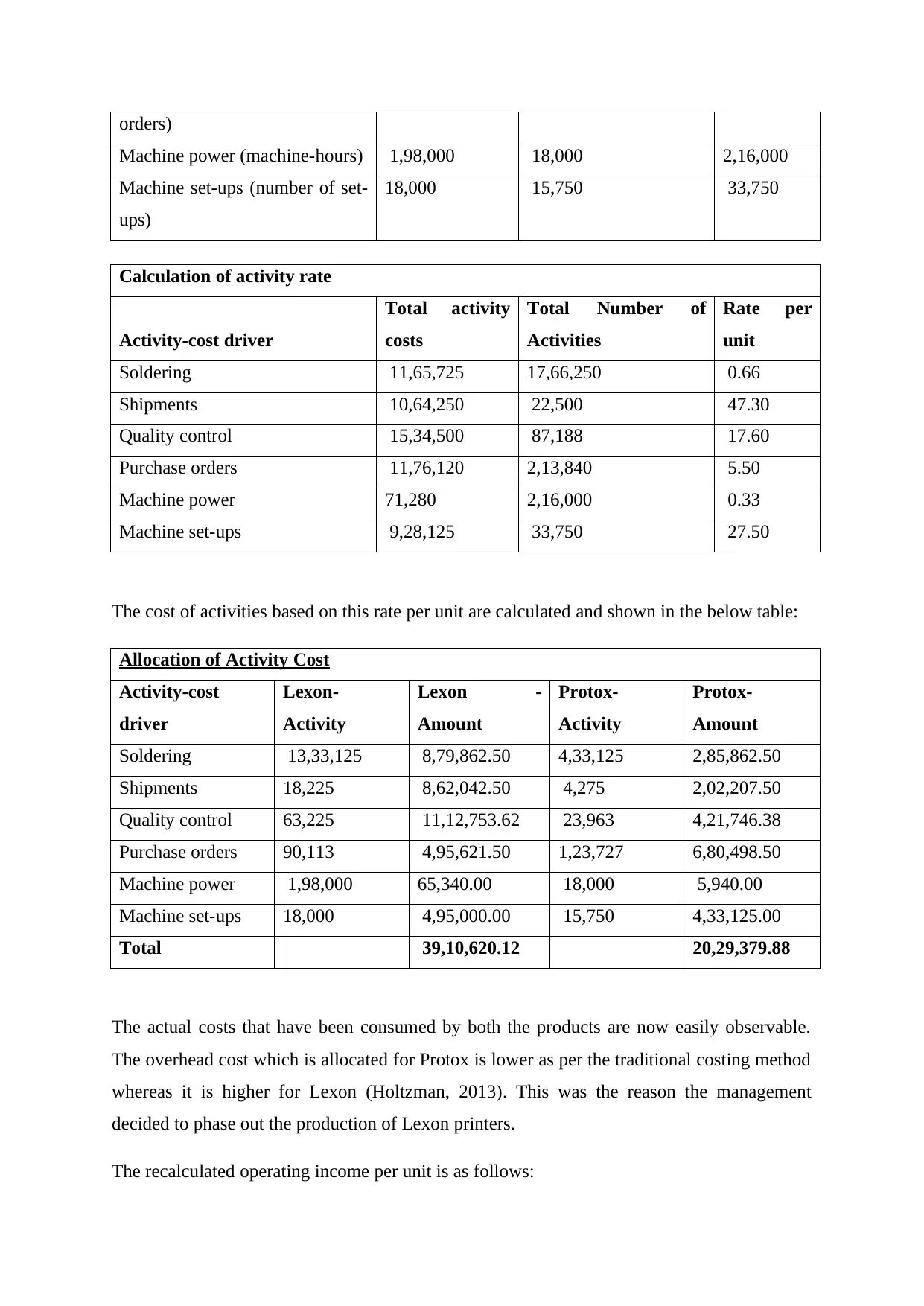
orders)
Machine power (machine-hours) 1,98,000 18,000 2,16,000
Machine set-ups (number of set-
ups)
18,000 15,750 33,750
Calculation of activity rate
Activity-cost driver
Total activity
costs
Total Number of
Activities
Rate per
unit
Soldering 11,65,725 17,66,250 0.66
Shipments 10,64,250 22,500 47.30
Quality control 15,34,500 87,188 17.60
Purchase orders 11,76,120 2,13,840 5.50
Machine power 71,280 2,16,000 0.33
Machine set-ups 9,28,125 33,750 27.50
The cost of activities based on this rate per unit are calculated and shown in the below table:
Allocation of Activity Cost
Activity-cost
driver
Lexon-
Activity
Lexon -
Amount
Protox-
Activity
Protox-
Amount
Soldering 13,33,125 8,79,862.50 4,33,125 2,85,862.50
Shipments 18,225 8,62,042.50 4,275 2,02,207.50
Quality control 63,225 11,12,753.62 23,963 4,21,746.38
Purchase orders 90,113 4,95,621.50 1,23,727 6,80,498.50
Machine power 1,98,000 65,340.00 18,000 5,940.00
Machine set-ups 18,000 4,95,000.00 15,750 4,33,125.00
Total 39,10,620.12 20,29,379.88
The actual costs that have been consumed by both the products are now easily observable.
The overhead cost which is allocated for Protox is lower as per the traditional costing method
whereas it is higher for Lexon (Holtzman, 2013). This was the reason the management
decided to phase out the production of Lexon printers.
The recalculated operating income per unit is as follows:
Machine power (machine-hours) 1,98,000 18,000 2,16,000
Machine set-ups (number of set-
ups)
18,000 15,750 33,750
Calculation of activity rate
Activity-cost driver
Total activity
costs
Total Number of
Activities
Rate per
unit
Soldering 11,65,725 17,66,250 0.66
Shipments 10,64,250 22,500 47.30
Quality control 15,34,500 87,188 17.60
Purchase orders 11,76,120 2,13,840 5.50
Machine power 71,280 2,16,000 0.33
Machine set-ups 9,28,125 33,750 27.50
The cost of activities based on this rate per unit are calculated and shown in the below table:
Allocation of Activity Cost
Activity-cost
driver
Lexon-
Activity
Lexon -
Amount
Protox-
Activity
Protox-
Amount
Soldering 13,33,125 8,79,862.50 4,33,125 2,85,862.50
Shipments 18,225 8,62,042.50 4,275 2,02,207.50
Quality control 63,225 11,12,753.62 23,963 4,21,746.38
Purchase orders 90,113 4,95,621.50 1,23,727 6,80,498.50
Machine power 1,98,000 65,340.00 18,000 5,940.00
Machine set-ups 18,000 4,95,000.00 15,750 4,33,125.00
Total 39,10,620.12 20,29,379.88
The actual costs that have been consumed by both the products are now easily observable.
The overhead cost which is allocated for Protox is lower as per the traditional costing method
whereas it is higher for Lexon (Holtzman, 2013). This was the reason the management
decided to phase out the production of Lexon printers.
The recalculated operating income per unit is as follows:
⊘ This is a preview!⊘
Do you want full access?
Subscribe today to unlock all pages.

Trusted by 1+ million students worldwide
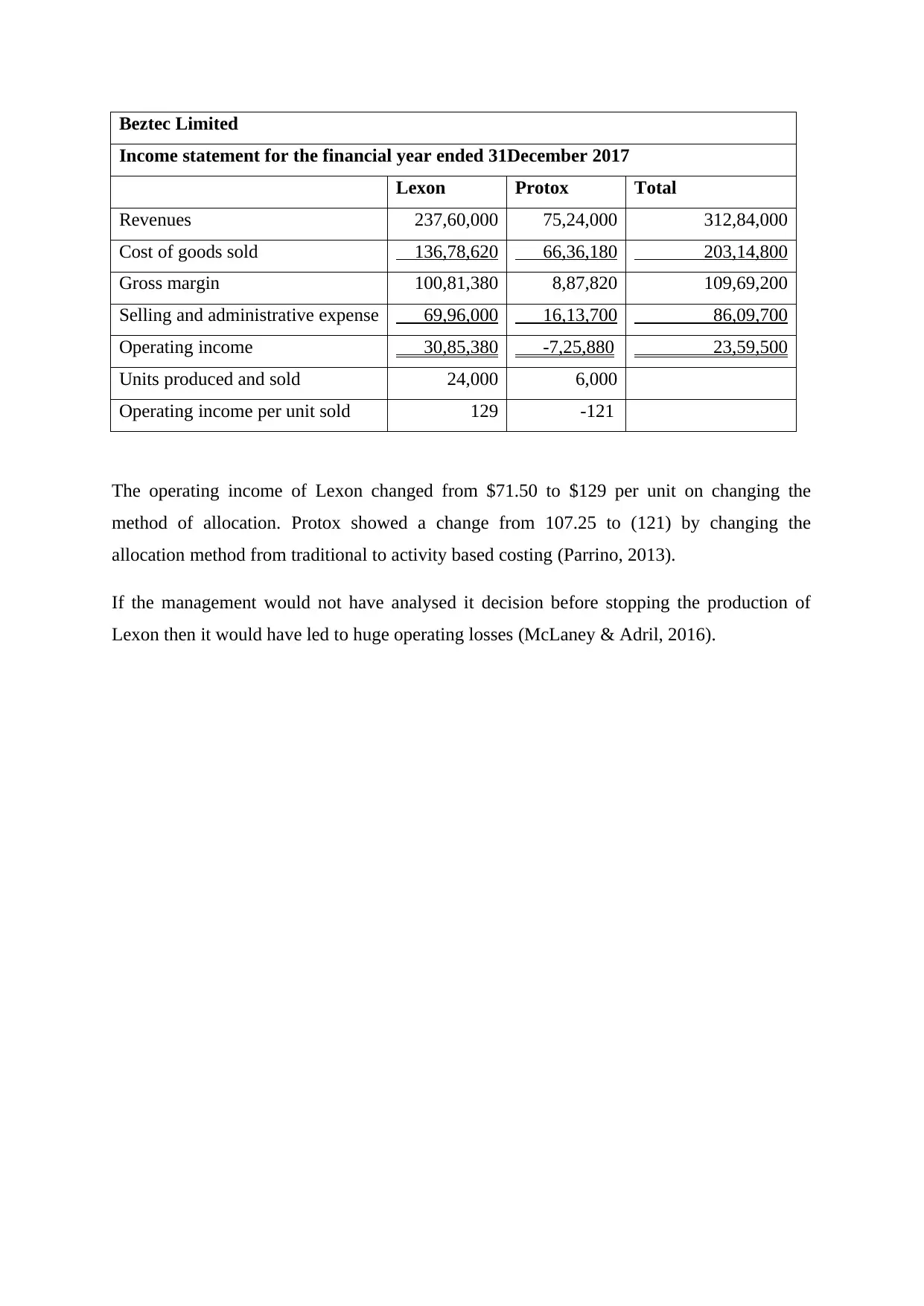
Beztec Limited
Income statement for the financial year ended 31December 2017
Lexon Protox Total
Revenues 237,60,000 75,24,000 312,84,000
Cost of goods sold 136,78,620 66,36,180 203,14,800
Gross margin 100,81,380 8,87,820 109,69,200
Selling and administrative expense 69,96,000 16,13,700 86,09,700
Operating income 30,85,380 -7,25,880 23,59,500
Units produced and sold 24,000 6,000
Operating income per unit sold 129 -121
The operating income of Lexon changed from $71.50 to $129 per unit on changing the
method of allocation. Protox showed a change from 107.25 to (121) by changing the
allocation method from traditional to activity based costing (Parrino, 2013).
If the management would not have analysed it decision before stopping the production of
Lexon then it would have led to huge operating losses (McLaney & Adril, 2016).
Income statement for the financial year ended 31December 2017
Lexon Protox Total
Revenues 237,60,000 75,24,000 312,84,000
Cost of goods sold 136,78,620 66,36,180 203,14,800
Gross margin 100,81,380 8,87,820 109,69,200
Selling and administrative expense 69,96,000 16,13,700 86,09,700
Operating income 30,85,380 -7,25,880 23,59,500
Units produced and sold 24,000 6,000
Operating income per unit sold 129 -121
The operating income of Lexon changed from $71.50 to $129 per unit on changing the
method of allocation. Protox showed a change from 107.25 to (121) by changing the
allocation method from traditional to activity based costing (Parrino, 2013).
If the management would not have analysed it decision before stopping the production of
Lexon then it would have led to huge operating losses (McLaney & Adril, 2016).
Paraphrase This Document
Need a fresh take? Get an instant paraphrase of this document with our AI Paraphraser
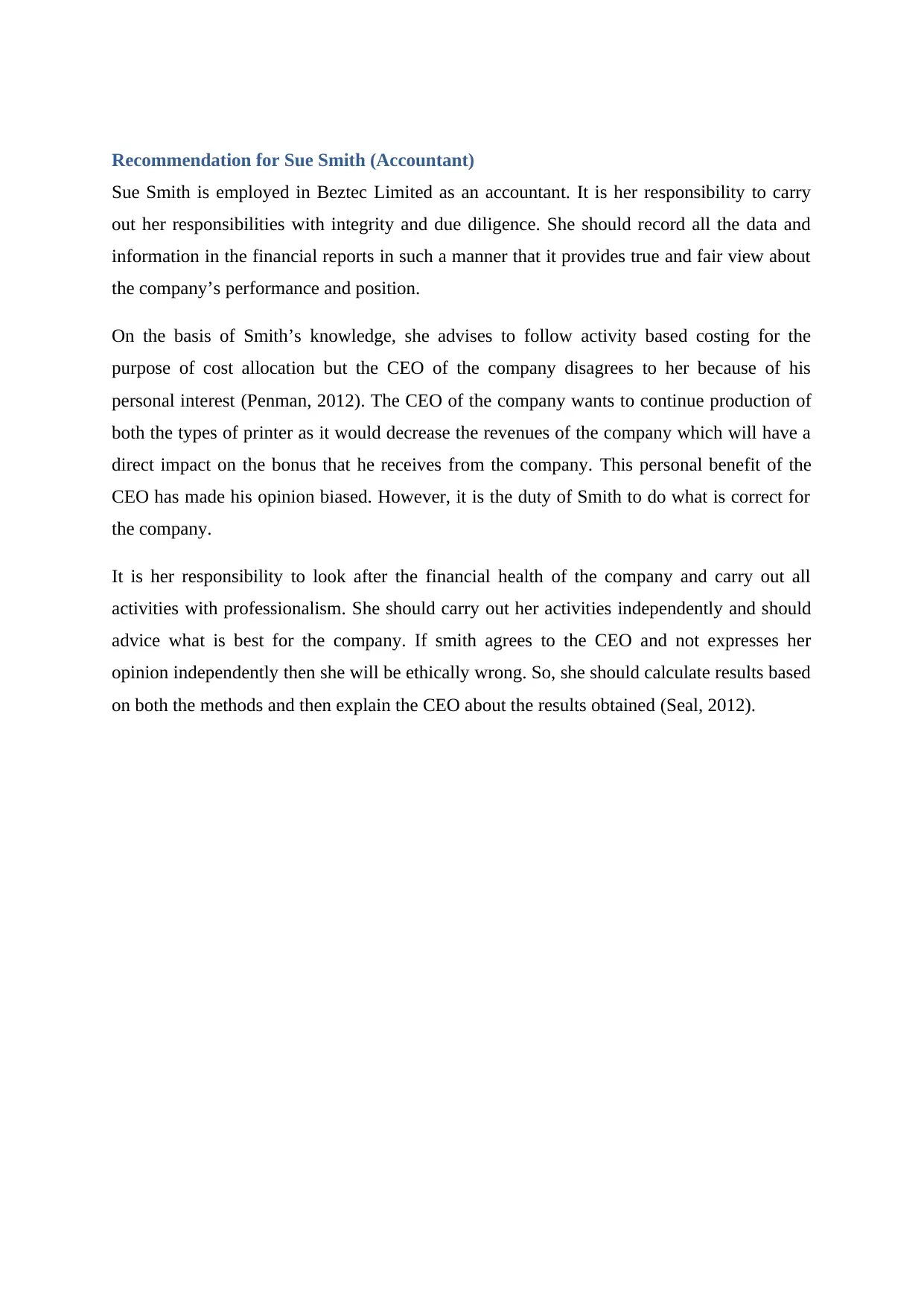
Recommendation for Sue Smith (Accountant)
Sue Smith is employed in Beztec Limited as an accountant. It is her responsibility to carry
out her responsibilities with integrity and due diligence. She should record all the data and
information in the financial reports in such a manner that it provides true and fair view about
the company’s performance and position.
On the basis of Smith’s knowledge, she advises to follow activity based costing for the
purpose of cost allocation but the CEO of the company disagrees to her because of his
personal interest (Penman, 2012). The CEO of the company wants to continue production of
both the types of printer as it would decrease the revenues of the company which will have a
direct impact on the bonus that he receives from the company. This personal benefit of the
CEO has made his opinion biased. However, it is the duty of Smith to do what is correct for
the company.
It is her responsibility to look after the financial health of the company and carry out all
activities with professionalism. She should carry out her activities independently and should
advice what is best for the company. If smith agrees to the CEO and not expresses her
opinion independently then she will be ethically wrong. So, she should calculate results based
on both the methods and then explain the CEO about the results obtained (Seal, 2012).
Sue Smith is employed in Beztec Limited as an accountant. It is her responsibility to carry
out her responsibilities with integrity and due diligence. She should record all the data and
information in the financial reports in such a manner that it provides true and fair view about
the company’s performance and position.
On the basis of Smith’s knowledge, she advises to follow activity based costing for the
purpose of cost allocation but the CEO of the company disagrees to her because of his
personal interest (Penman, 2012). The CEO of the company wants to continue production of
both the types of printer as it would decrease the revenues of the company which will have a
direct impact on the bonus that he receives from the company. This personal benefit of the
CEO has made his opinion biased. However, it is the duty of Smith to do what is correct for
the company.
It is her responsibility to look after the financial health of the company and carry out all
activities with professionalism. She should carry out her activities independently and should
advice what is best for the company. If smith agrees to the CEO and not expresses her
opinion independently then she will be ethically wrong. So, she should calculate results based
on both the methods and then explain the CEO about the results obtained (Seal, 2012).
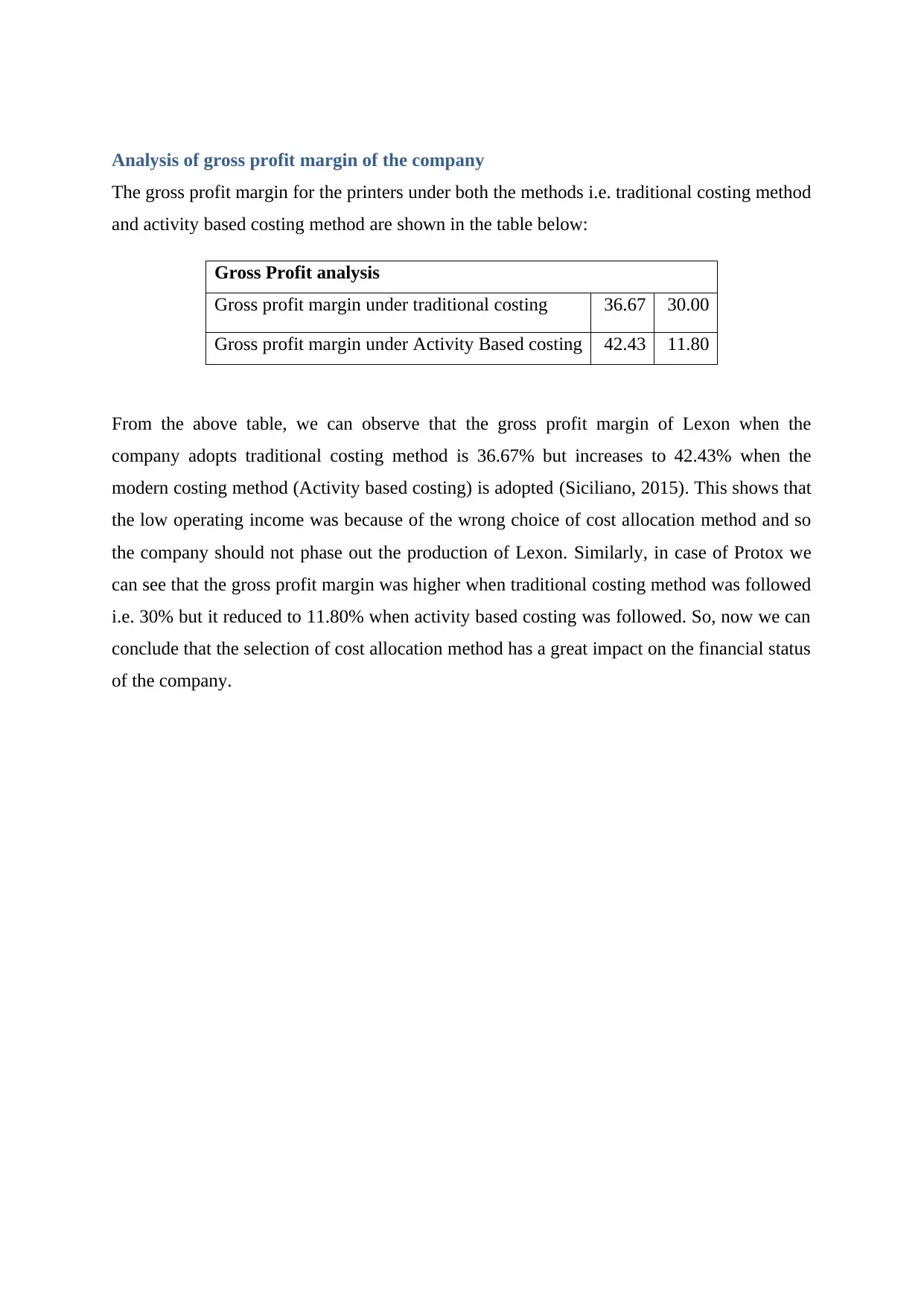
Analysis of gross profit margin of the company
The gross profit margin for the printers under both the methods i.e. traditional costing method
and activity based costing method are shown in the table below:
Gross Profit analysis
Gross profit margin under traditional costing 36.67 30.00
Gross profit margin under Activity Based costing 42.43 11.80
From the above table, we can observe that the gross profit margin of Lexon when the
company adopts traditional costing method is 36.67% but increases to 42.43% when the
modern costing method (Activity based costing) is adopted (Siciliano, 2015). This shows that
the low operating income was because of the wrong choice of cost allocation method and so
the company should not phase out the production of Lexon. Similarly, in case of Protox we
can see that the gross profit margin was higher when traditional costing method was followed
i.e. 30% but it reduced to 11.80% when activity based costing was followed. So, now we can
conclude that the selection of cost allocation method has a great impact on the financial status
of the company.
The gross profit margin for the printers under both the methods i.e. traditional costing method
and activity based costing method are shown in the table below:
Gross Profit analysis
Gross profit margin under traditional costing 36.67 30.00
Gross profit margin under Activity Based costing 42.43 11.80
From the above table, we can observe that the gross profit margin of Lexon when the
company adopts traditional costing method is 36.67% but increases to 42.43% when the
modern costing method (Activity based costing) is adopted (Siciliano, 2015). This shows that
the low operating income was because of the wrong choice of cost allocation method and so
the company should not phase out the production of Lexon. Similarly, in case of Protox we
can see that the gross profit margin was higher when traditional costing method was followed
i.e. 30% but it reduced to 11.80% when activity based costing was followed. So, now we can
conclude that the selection of cost allocation method has a great impact on the financial status
of the company.
⊘ This is a preview!⊘
Do you want full access?
Subscribe today to unlock all pages.

Trusted by 1+ million students worldwide
1 out of 15
Related Documents
Your All-in-One AI-Powered Toolkit for Academic Success.
+13062052269
info@desklib.com
Available 24*7 on WhatsApp / Email
![[object Object]](/_next/static/media/star-bottom.7253800d.svg)
Unlock your academic potential
Copyright © 2020–2025 A2Z Services. All Rights Reserved. Developed and managed by ZUCOL.





